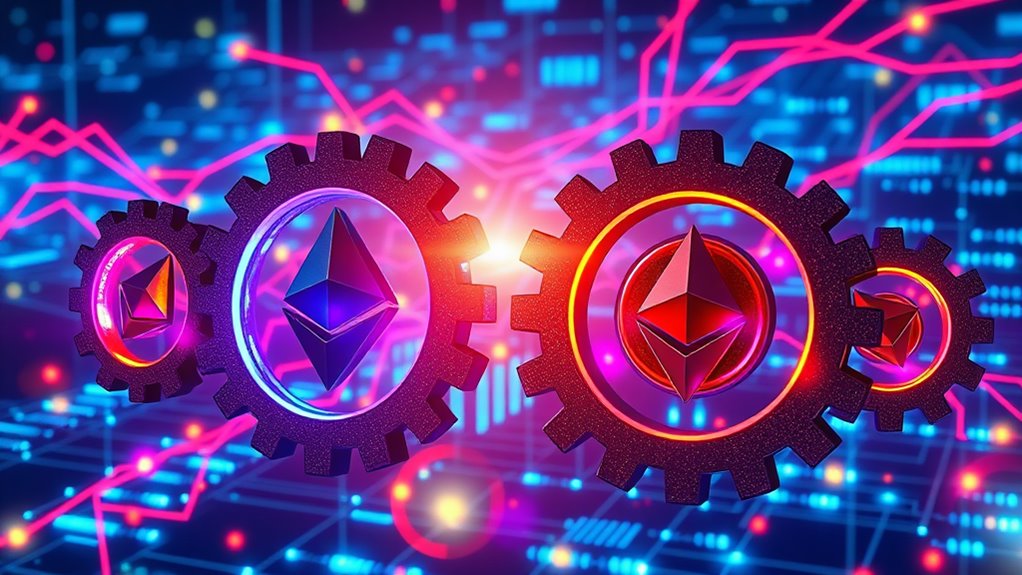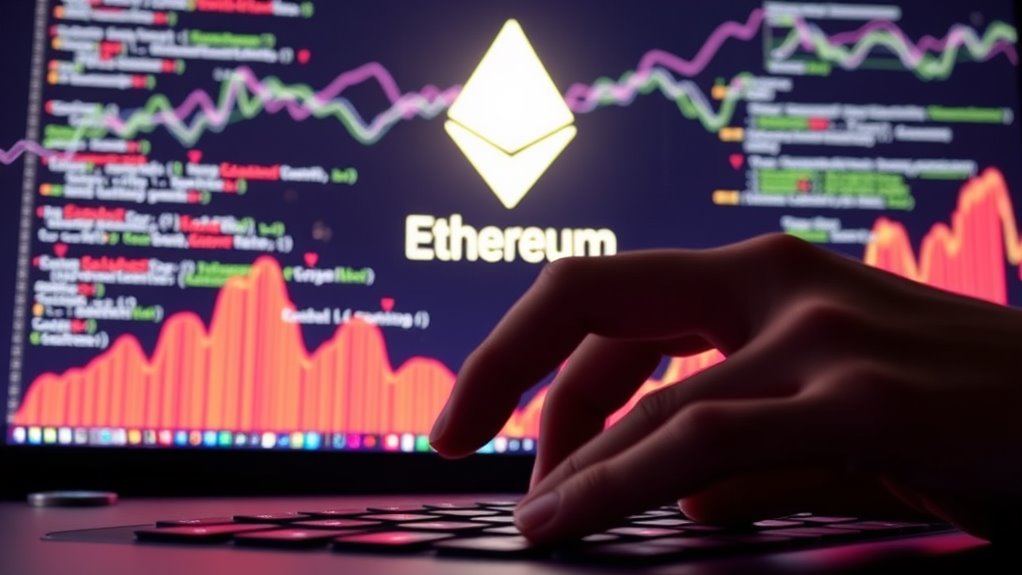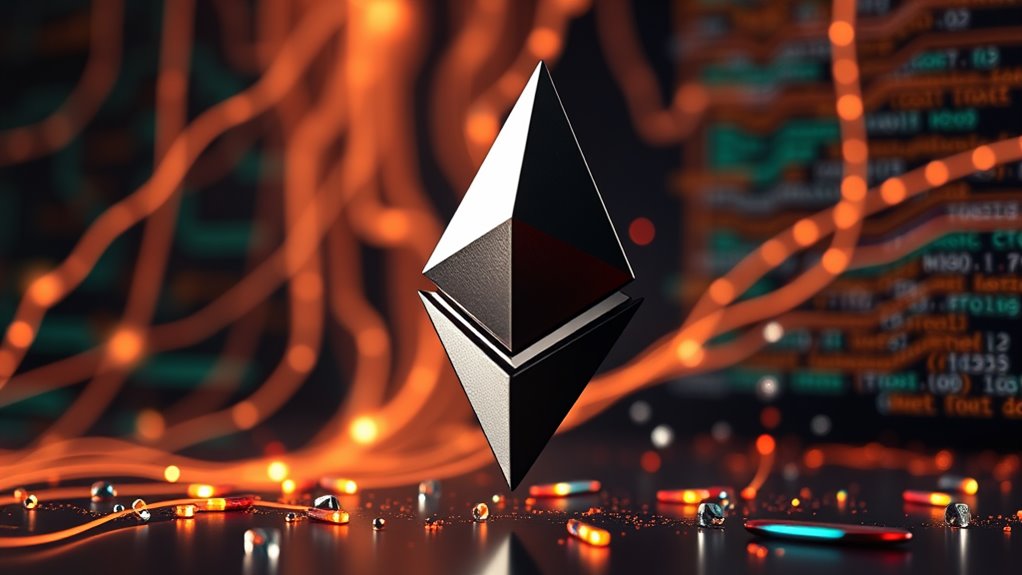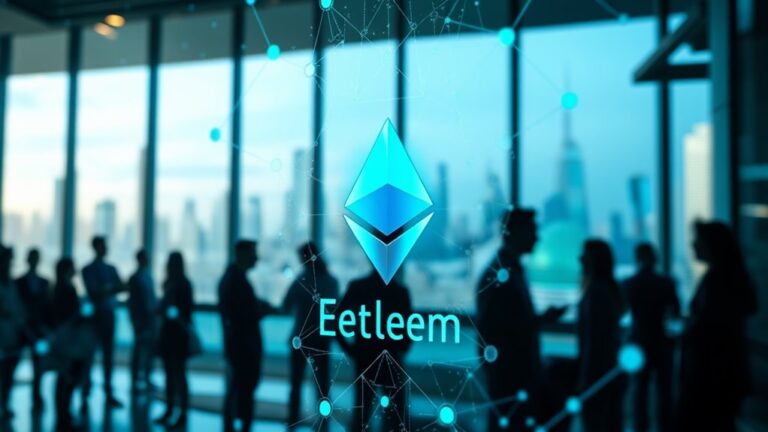
Ethereum Forks and Network Upgrades: Enhancing Scalability & Security.
Ethereum’s network upgrades have transformed its architecture from energy-intensive Proof-of-Work to efficient Proof-of-Stake. Major milestones include The Merge (2022), which reduced energy usage by 99.5%, the Shanghai upgrade (2023) enabling staked ETH withdrawals, and Dencun (2024) implementing proto-danksharding to lower Layer 2 transaction costs. These improvements enhance security through validator systems and economic deterrents while supporting scalability via Layer 2 solutions. Future upgrades like Prague/Electra promise further optimization for decentralized finance applications.
Key Takeaways
- Ethereum’s transition from Proof-of-Work to Proof-of-Stake reduced energy consumption by 99.5% while enhancing security and scalability.
- The Merge (2022) and Shanghai Upgrade (2023) established sustainable consensus mechanics and unlocked staking rewards for validators.
- Dencun Upgrade (2024) implemented proto-danksharding with blob-carrying transactions, reducing Layer 2 transaction costs by 10-20x.
- Layer 2 solutions like Optimistic and ZK-rollups bundle transactions off-chain while inheriting Ethereum’s security properties.
- EIP-4844’s data blobs reduce transaction costs while slashing penalties deter malicious behavior, creating a more secure economic model.
The Evolution of Ethereum Network Architecture

How has Ethereum’s foundational architecture transformed since its inception?
Ethereum began with a decentralized blockchain structure designed to enable trustless interactions and computation through its distributed ledger technology. At its core, the Ethereum Virtual Machine (EVM) provides a runtime environment for executing smart contracts across the network.
The most significant transformation came through the consensus mechanism shift from Proof of Work to Proof of Stake, dramatically reducing energy consumption while enhancing security and scalability. This evolution introduced a validator system that selects participants based on cryptocurrency holdings rather than computational puzzles.
Further architectural advancements include layered solutions – with Layer 1 improvements like shard chains increasing capacity and Layer 2 solutions such as rollups enabling off-chain processing to reduce costs.
The transition to Proof of Stake has not only minimized the environmental impact but also incentivized honest behavior among validators, promoting a more secure network.
Proto-Danksharding, part of recent upgrades, has further reduced data costs through “blob” storage.
Key Milestones in Ethereum’s Upgrade Journey

Ethereum’s architectural evolution established the foundation for a series of strategic network upgrades that have shaped its capabilities and future potential.
These upgrades address scalability, security, and sustainability challenges while improving user experience.
Ethereum’s evolution tackles core infrastructure limitations while enhancing functionality for developers and users alike.
- The Merge (2022) – Changed Ethereum from energy-intensive Proof-of-Work to environmentally sustainable Proof-of-Stake, reducing energy consumption by over 99%.
- Shanghai Upgrade (2023) – Enabled validators to withdraw staked ETH and access rewards, enhancing usability for network validators.
- Dencun Upgrade (2024) – Implemented proto-danksharding (EIP-4844) to greatly reduce Layer 2 transaction costs by minimizing permanent data storage.
- Upcoming Prague/Electra & Pectra (2025) – Will focus on network optimizations, addressing economic centralization risks, and improving transaction efficiency. Additionally, these upgrades will support the growth of decentralized finance (DeFi) as a key component of Ethereum’s expanding ecosystem.
The Merge: Transforming Ethereum’s Consensus Mechanism

When the Ethereum network completed The Merge in September 2022, it marked one of the most significant technical upgrades in blockchain history. This shift moved Ethereum from energy-intensive Proof-of-Work to the more sustainable Proof-of-Stake consensus mechanism, reducing energy consumption by over 99.5%.
| Aspect | Before Merge | After Merge |
|---|---|---|
| Consensus | Proof-of-Work | Proof-of-Stake |
| Participants | Miners | Validators |
| Energy Use | High | Reduced by 99.5% |
| Entry Requirement | Mining hardware | 32 ETH stake |
The upgrade required no action from users and preserved all transaction history and assets. While The Merge didn’t immediately reduce gas fees or increase transaction speeds, it established the foundation for future scalability improvements through sharding and other planned upgrades. Furthermore, this transition is essential for integrating Layer 2 solutions, which aim to enhance Ethereum’s scalability and efficiency further.
Dencun Upgrade and Proto-Danksharding Implementation

The Dencun upgrade introduced Proto-Danksharding, which markedly enhances Ethereum’s data availability through specialized blob-carrying transactions.
This innovation specifically addresses the high costs of Layer 2 rollups, with estimates suggesting fee reductions between 10 to 20 times their previous levels.
While the technical implementation faced challenges related to consensus mechanisms and data storage optimization, developers overcame these hurdles to successfully deploy the upgrade on March 13, 2024. Additionally, this upgrade contributes to the overall DeFi ecosystem, further enabling decentralized financial services on Ethereum.
Proto-Danksharding’s Data Benefits
Introduced as part of the Dencun upgrade, proto-danksharding represents a revolutionary approach to data management within Ethereum’s architecture.
This implementation through EIP-4844 establishes a foundation for significant improvements in network efficiency and cost reduction.
The key benefits of proto-danksharding include:
- Substantial reduction in data costs compared to traditional calldata methods, making transactions more affordable for users.
- Enhanced scalability through efficient handling of large data sets via temporary blob storage.
- Sustainable network growth by implementing data expiry mechanisms that prevent excessive blockchain bloat.
- Future-proofing the Ethereum ecosystem by creating infrastructure compatible with full danksharding and other upcoming scalability solutions.
These improvements enable layer-2 solutions to operate more efficiently while maintaining Ethereum’s security guarantees. Moreover, the transition to a proof-of-stake mechanism has been instrumental in supporting these advancements.
Lower Rollup Costs
Slashing transaction costs dramatically, the Dencun upgrade has revolutionized Ethereum’s Layer 2 ecosystem through its implementation of proto-danksharding. By introducing “blob space” for more efficient data storage, the upgrade has reduced rollup fees by at least tenfold, with transactions on networks like Optimism now costing below $0.10.
Prior to Dencun’s March 2024 implementation, rollups were constrained by Ethereum’s high mainchain fees. The shift from traditional calldata to blob-carrying transactions has optimized data storage costs while maintaining security.
This enhancement decreases network congestion by encouraging greater Layer 2 activity, making decentralized applications more accessible to everyday users. The cost reduction represents a significant competitive advantage for Ethereum against faster blockchain alternatives, while setting the foundation for further scalability improvements through future sharding enhancements. Additionally, this upgrade aligns with Ethereum’s broader goal of fostering a more decentralized internet ecosystem that empowers user autonomy and data ownership through decentralized applications.
Technical Implementation Challenges
While the cost reduction benefits of Dencun were substantial, implementing the upgrade itself presented numerous technical hurdles for Ethereum developers.
The dual-layer approach of simultaneously updating both Deneb (consensus layer) and Cancun (execution layer) added significant complexity to the process.
Four primary challenges emerged during implementation:
- Low validator participation during testnet activations, causing consensus issues
- Integration of proto-danksharding’s blob data storage mechanism with existing systems
- Extensive testing requirements across multiple testnets (Goerli, Sepolia, and Holesky)
- Complex orchestration of the shift to guarantee network stability
These challenges pushed the original deployment timeline from late 2023 into 2024, as developers worked meticulously to guarantee the upgrade would function properly without compromising Ethereum’s security or reliability. Additionally, the implications of Ethereum gas fees became more prominent, as the upgrade aimed to enhance scalability while reducing transaction costs for users.
Pectra: The Next Frontier in Ethereum Development

As Ethereum continues to evolve, the Pectra upgrade represents one of the most significant advancements in the network’s development roadmap. This dual-layer hard fork combines Prague (execution layer) and Electra (consensus layer) upgrades, scheduled for mainnet deployment in April 2025.
| Feature | Benefit |
|---|---|
| Improved Scalability | Faster transaction processing and reduced network congestion |
| Enhanced Security | Advanced cryptographic techniques protecting user data |
| Staking Flexibility | Validators can stake between 32-2048 ETH |
| Smart Accounts | EIP-7702 enables EOAs to execute smart contract logic |
| Streamlined Operations | On-chain deposits and exits reduce validator overhead |
Pectra builds upon previous upgrades like Dencun while setting the foundation for future developments including Verkle trees in Phase 2. The improvements are expected to strengthen Ethereum’s competitive position while creating a more accessible user experience. Furthermore, the decentralized digital ledger technology underlying Ethereum has the potential to redefine how transactions are verified and recorded across various industries.
Layer 2 Solutions and Rollup Technology

Ethereum’s ambitious Pectra upgrade represents just one facet of the network’s scalability strategy.
Layer 2 solutions operate alongside the main Ethereum blockchain, processing transactions off-chain while inheriting the security of the underlying network. These solutions drastically reduce gas fees and increase throughput, addressing Ethereum’s congestion challenges.
Among Layer 2 technologies, rollups have emerged as the dominant scaling solution by bundling multiple transactions into single on-chain submissions:
- Optimistic rollups assume transactions are valid until proven otherwise through fraud proofs.
- ZK-rollups utilize zero-knowledge proofs for immediate verification with enhanced privacy.
- State channels enable direct off-chain transactions between specific participants.
- Sidechains offer interoperability between different blockchain networks.
Despite implementation complexities and liquidity fragmentation concerns, Layer 2 adoption continues to accelerate, supporting DeFi and NFT ecosystem growth.
Economic Impact of Ethereum’s Scalability Improvements

The economic repercussions of Ethereum’s scalability advancements extend far beyond technical improvements, reshaping the network’s financial ecosystem in profound ways. EIP-4844’s introduction of data blobs has greatly reduced transaction costs, making the platform more accessible to developers and users alike. This affordability stimulates innovation and broadens market appeal.
However, these improvements create financial challenges. Reduced rent payments from Layer 2 solutions to Ethereum have altered revenue streams, potentially affecting ETH supply dynamics. The network may need to develop alternative income sources to maintain sustainability.
Despite these challenges, lower fees provide Ethereum with a competitive advantage against rival blockchains. Enhanced efficiency attracts institutional investors and guarantees the network’s long-term viability as a decentralized application platform, though continued success still depends on Layer 1 transactions. Furthermore, Ethereum’s shift to Proof of Stake has contributed to its scalability efforts, allowing for faster transaction processing.
Security Enhancements Through Proof-of-Stake

Revolutionary shifts in blockchain security emerged when Ethereum changed to Proof-of-Stake (PoS), fundamentally altering how the network protects itself against attacks.
This change established a robust security model that requires validators to stake 32 ETH, creating significant economic disincentives for malicious behavior.
The PoS security improvements include:
- Financial deterrence through slashing penalties that can result in validators losing their staked ETH
- Enhanced resilience against 51% attacks by making them prohibitively expensive
- Protection against long-range attacks through finality gadgets and advanced consensus mechanisms
- Improved detection and punishment systems that quickly identify and penalize dishonest validators
These changes have made Ethereum more secure by aligning validators’ economic interests with network health, creating a self-reinforcing system where honest participation yields the greatest rewards. Additionally, staking allows ETH holders to contribute to network security while earning rewards, further incentivizing honest behavior.
Environmental Sustainability and Energy Efficiency Gains

When Ethereum completed its shift to Proof-of-Stake in September 2022, a remarkable transformation in energy consumption occurred, reducing the network’s power requirements by over 99% compared to its previous Proof-of-Work model. This change dramatically decreased Ethereum’s environmental impact, with energy usage falling from 21.41 TWh to merely 0.0026 TWh annually.
| Metric | Before Merge | After Merge |
|---|---|---|
| Annual Energy (TWh) | 21.41 | 0.0026 |
| CO2 Emissions (tonnes) | 10.26 million | 870 |
| Equivalent Power | Large country | 2,100 American homes |
| Energy Source | Primarily non-renewable | 48% renewable |
| Environmental Impact | Significant carbon footprint | Near-zero emissions |
This substantial improvement positions Ethereum as an environmentally responsible blockchain platform, consuming less energy than many centralized systems while maintaining network security and functionality.
The Road Ahead: Verkle Trees and Sharding

As Ethereum continues to evolve beyond the Merge, two vital technological innovations stand at the forefront of its development roadmap: Verkle trees and sharding.
These upgrades represent the next phase in Ethereum’s journey toward enhanced scalability without compromising security or decentralization.
- Verkle trees improve upon Merkle trees by creating flatter structures with polynomial commitments, dramatically reducing proof sizes.
- These reduced proofs enable stateless clients, a vital advancement for network efficiency.
- Sharding divides the network into parallel segments, allowing transactions to be processed simultaneously across multiple chains.
- Together, these technologies will increase throughput capacity while maintaining Ethereum’s security model and reducing hardware requirements for validators.
The integration of these innovations, particularly as part of “The Verge” phase, faces significant technical challenges but promises substantial rewards for network scalability.
Frequently Asked Questions
How Do Ethereum Upgrades Affect Existing Smart Contracts?
Ethereum upgrades can introduce new features that affect smart contracts, potentially breaking assumptions. They improve scalability, enhance security, future-proof the network, and increase interoperability while requiring complex adaptation strategies for existing contracts.
Can Regular Investors Participate in Ethereum Network Governance Decisions?
Regular investors navigate a limited governance landscape. While they can participate in discussions on platforms like GitHub and Ethereum Magicians, Ethereum lacks direct voting mechanisms for investors in protocol-level decision-making processes.
What Happens to Non-Upgraded Nodes During a Hard Fork?
Non-upgraded nodes become isolated, operating on the old blockchain version. They cannot validate new blocks, lose consensus participation, and their assets aren’t recognized by the upgraded network, potentially resulting in reduced security and support.
How Do Validators Get Selected for Block Production?
Like a cosmic lottery drawing names from the stars, validators on Ethereum are selected through the RANDAO mechanism, which provides unpredictable randomness every 12 seconds to guarantee security and fairness in block production.
Will Transaction Finality Time Improve With Future Upgrades?
Transaction finality time is expected to improve considerably with future Ethereum upgrades. Single-Slot Finality aims to reduce the current 13-minute finalization period to just seconds, enhancing user experience and network competitiveness.
Conclusion
Ethereum’s evolution from a nascent blockchain to a global computing infrastructure demonstrates its resilience and adaptability. Through strategic forks, innovative upgrades, and community consensus, Ethereum continues to balance scalability, security, and sustainability. As Verkle trees and sharding approach implementation, Ethereum stands at the threshold of a new era—where technical excellence meets practical utility, where vision meets execution, and where the promise of decentralization moves steadily toward fulfillment.












